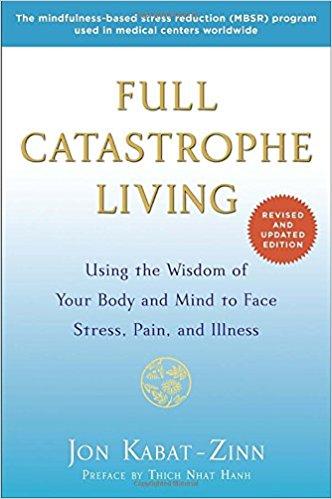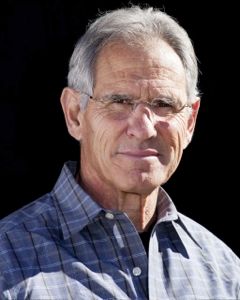Full Catastrophe Living Summary

5 min read ⌚
 Using the Wisdom of Your Body and Mind to Face Stress, Pain, and Illness
Using the Wisdom of Your Body and Mind to Face Stress, Pain, and Illness
Do you ever stop and look around you? Or do you just rush through your life, chasing deadlines and achieving goals, while not enjoying the journey?
What if we told you that the real path toward reaching all of your goals and happiness is getting to know yourself, and fully experiencing everything that is happening to you?
In our summary, we offer John Kabat-Zinn’s teachings on using mindfulness to relieve stress.
Of course, you can find many other ways to use mindfulness to enrich your life in “Full Catastrophe Living.”
Who Should Read “Full Catastrophe Living”? And Why?
Jon Kabat Zinn published the first edition of “Full Catastrophe Living” in 1990. However, his lessons on mindfulness are as relevant today as when he first created them.
In the book, you will learn many exercises to reach mindfulness and many ways you can benefit from it.
We recommend this book to all people who feel stressed and pressured – after reading this, they will find the cure for all of their troubles in their own mind and body.
About Jon Kabat-Zinn
 Jon Kabat-Zinn is an author, a professor of Medicine Emeritus, founder of the Center for Mindfulness in Medicine, Health Care and Society at the University of Massachusetts.
Jon Kabat-Zinn is an author, a professor of Medicine Emeritus, founder of the Center for Mindfulness in Medicine, Health Care and Society at the University of Massachusetts.
He is also the creator of the mindfulness movement and the mindfulness-based stress reduction program (MBSR).
“Full Catastrophe Living Summary”
You have heard it so many times – the magic word that creates order in your chaotic world.
Mindfulness.
But what is mindfulness? How can you practice it?
By definition, mindfulness is “the awareness that arises by paying attention on purpose, in the present moment, and nonjudgmentally.”
In other words, mindfulness is living in the “now.” It is the biggest gift you can give to yourself, and what will enrich your life in a way you never thought was possible.
There are many ways and meditations that you can use to start your mindfulness journey.
We will start with the simplest one.
Sit down, rooted to your chair or sofa, eyes closed, and pay attention to your breathing. You will get different thoughts, but do not focus on them. Do not try to fight them. Just let them pass.
You may be uncomfortable, but that does not matter. The point is to experience everything you are feeling at the moment.
Now, close your eyes and do this for three minutes.
Did you finish? Okay, now do this daily. Soon, you will start getting more comfortable in your own skin.
As you become more aware, all experiences and relationships in your life will bloom. Awareness will even transform the ways you experience pain and stress.
What we can advise you to do is to create a mindfulness routine. You have to create the habit of mindfulness intentionally, or otherwise, you will see no results.
The “prescribed” time you need to meditate daily is 45 minutes. Try to commit to it for at least eight weeks. You can check out the author’s guided Series 1 meditations.
But isn’t meditating hard?
It may be, in the beginning, since your mind will continue producing unwanted thoughts. But as time goes by and you go further in your meditation practice, you will learn how to just observe the thoughts and let them go.
In the beginning, focus on your breathing. It is undoubtedly the simplest way to become mindful.
Feel all the sensations in your body while you are taking breaths in and out. When your mind drifts (and it will), do not judge yourself and just go back to focusing on your breathing.
You will be amazed at how much breathing can calm you down.
Also, you should try mindful walking as well. Yes, even walking can be a meditation.
Just set aside some portion of your time in which you will calmly walk. Feel the sensations and watch around you.
Do this practice with all your tasks.
Stop being stuck in the future or the moments of the past, while letting the real, present life pass by unnoticed.
Admire everything.
Your surroundings, your extraordinary body. Feel the connection with the world and realize that you are not alone – that you are part of a bigger picture.
Key Lessons from “Full Catastrophe Living”
1. “Mindfulness-Based Stress Reduction” (MBSR) Factors
2. Ways to “Free Yourself from the Tyranny of Time”
3. Stress and Mindfulness
“Mindfulness-Based Stress Reduction” (MBSR) Factors
-
- “Non-judging”: we constantly label things. We are not attacking you; you do not need to stop it, just become aware when you do it.
-
- “Patience”: some things take time. Stop the rush and enjoy each moment.
-
- “Beginner’s mind”: try to look at all your everyday experience like they are happening for the first time.
-
- “Trust”: trust your experience.
-
- “Non-striving”: the only one that can take you to all your goals is your true self. Meditation can show you who you are.
-
- “Acceptance”: practice full acceptance of things as they already are.
- “Letting go”: letting go of specific thoughts or feelings is crucial.
Ways to “Free Yourself from the Tyranny of Time”
-
- Realize that “time is a product of thought.”
-
- “Live in the present.”
-
- Make some time “each day just to be”
- “Simplify your life.”
Stress and Mindfulness
What we have explained so far is all great, but what can you do when you feel stressed? Or when something bad happens? Should you shut down your feelings and try to be calm?
No.
Instead, when you are in an unwanted situation, let it be. Live through all the feelings you feel, become aware of the tension in your body.
Do not escape the feelings. Just become aware of them. It will help you react appropriately.
Just make sure that you are not self-inducing the stress. Stop living in a rush, and believing the myth of “lack of time.” Time is just a perception, which you have to learn how to manage.
Like this summary? We’d Like to invite you to download our free 12 min app, for more amazing summaries and audiobooks.
“Full Catastrophe Living” Quotes
You have to accept yourself as you are before you can really change. Share on X If we can learn to see change as an integral part of life and not as a threat to our wellbeing, we will be in a much better position to cope effectively with stress. Share on X When we are mindful of our breathing, it automatically helps us to establish greater calmness. Share on X If you are pressed for time, being in the present gives you more time by giving you back the fullness of each moment that you already have. Share on X Knowing what you are doing while you are doing it is the essence of mindfulness practice. Share on XOur Critical Review
Jon Kabat Zinn is a true teacher of mindfulness. “Full Catastrophe Living” offers various ways to implement mindfulness, and a pile of mindfulness-inducing techniques which you can use immediately, and reach that serene place that can do wonders for you.








